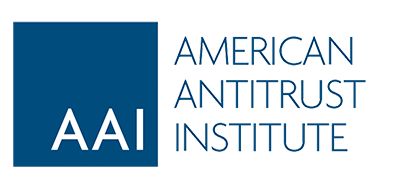Today, the AAI released the first part of its new White Paper series on Competition in the Delivery and Payment of Healthcare Services. Part I of this important and comprehensive competition analysis addresses “Consolidation in Provider and Insurer Markets: Enforcement Issues and Priorities.” The White Papers are co-authored by two of AAI’s Advisory Board competition experts: Thomas Greaney, Visiting Professor at the University of California Hastings College of Law and Chester A. Myers Professor Emeritus at Saint Louis University School of Law; and Barak Richman, the Edgar P. & Elizabeth C. Bartlett Professor of Law and Business Administration at Duke University.
The U.S. healthcare sector is undergoing rapid change. Providers and payers are adopting new organizational forms as payment methods and delivery models transform. Some of the changes underway have been spurred by the Affordable Care Act (ACA). Others are the result of market forces and sectoral changes that were long underway before the ACA was passed. Still others are in anticipation of a new policy direction from Republican policymakers. And virtually all changes in some way relate to the private sector’s efforts to adapt to new revenue models and technologies.
Many of these forces have created strong financial incentives for assorted healthcare entities to join forces, some opportunistically to aggregate market power, and some to bring greater value to an inefficient delivery system. Though there is little empirical doubt that competitive markets generate enormous benefits for patients and consumers, reducing the cost of healthcare while improving its quality, the need for swift and predictably pro-competitive policies may never be more pressing than it is today.
Unfortunately, the current policy environment has inherited healthcare markets that for many years suffered from inadequate antitrust attention. Among policymakers’ most pressing challenges is to confront the market harms stemming from unchallenged transactions that now bestow many market participants with monopoly power. Attentive antitrust enforcement—with a particular focus on merger review—is therefore critical to assure that the pro-competitive benefits of financial and clinical integration are not thwarted by excessive concentration, collusion, or abuse of dominant positions. Pervasive market concentration stemming from inadequate enforcement in prior years leaves current policymakers little room for error and has raised the stakes for today’s enforcement challenges.
The current challenges confronting the healthcare markets involve both a recurrence of the familiar horizontal mergers among providers and insurers and also a complex set of new vertical arrangements. Because the policy community cannot afford to continue playing catch-up, realizing the competitive harms of certain industrial realignments only after they win regulatory or judicial approval, antitrust law must be aggressive and decisive. The most recent wave of transactions pose special threats to competition in many geographic markets, in part because the competitive harms are less familiar and because the rate of integration is outpacing what traditional agency resources can police.
The foregoing problem arises in part from the rush to consolidation induced by hospitals and physicians wanting to be assured they will be in a strong bargaining position. But formation of large and dominant integrated systems creates the potent risk that many local delivery markets will be deprived of effective inter-system rivalry. Absent meaningful rivalry, horizontally and vertically integrated entities—including large health systems and Accountable Care Organizations (ACOs)—will not face incentives to innovate, conserve costs, or pass on savings to consumers.
Vigorous antitrust enforcement is even more urgent in light of current market conditions. For example, U.S. healthcare spending now amounts to over 18% of GDP and dwarfs healthcare spending in all the other OECD nations. Recent research confirms that this is predominantly because Americans pay higher prices than foreign counterparts for comparable services and products. Much of this pricing power has been linked to the inability and reticence of antitrust policymakers—federal agencies, state officials, and the courts—to prevent industry consolidation in the late 1980s through the mid-00s. We should bear in mind that nation’s economy is paying for past policy failures, and the more unsustainable healthcare spending becomes, the more the nation can ill-afford an ambivalent competition agenda.
Part I of the White Paper series identifies and analyzes the major concerns and priorities surrounding consolidation in the markets for delivery and payment of healthcare services. It takes a close look at the myriad competitive issues raised by ongoing consolidation in provider and insurers markets. These are multidimensional issues that raise substantive concerns for enforcers and courts. They also suggest a useful agenda for furthering academic and policy research that supports more vigorous enforcement.
The first section of the White Paper addresses consolidation and market power in provider markets. This includes horizontal and vertical mergers involving hospitals, physician practices, ACOs. The second section considers consolidation in the health insurer sector, including horizontal insurer mergers and vertical mergers involving insurers and other entities, such as pharmacy benefit managers (PBMs). The final section concludes with policy recommendations.
Some of the major takeaways from the analysis include:
- Absent meaningful rivalry, rivals in provider and payment markets will not face incentives to innovate, conserve costs, or pass on savings to consumers. Vigorous antitrust enforcement, with a particular focus on merger review, is critical to assure that the pro-competitive benefits of financial and clinical integration are not thwarted by excessive concentration, collusion, or abuse of dominant positions.
- Enforcers should aggressively pursue harmful provider mergers. The Federal Trade Commission (FTC) has recently successfully demonstrated that concentrative hospital mergers did meaningful harm to consumers and judicial opinion on hospital mergers in recent years has been marked by a number of important changes, ranging from finding for more local geographic markets, to rejecting arguments that the ACA limits the antitrust laws or that large insurance companies with purchasing power should mitigate concerns about mergers to monopoly.
- Research on cross-market mergers has accelerated as their incidence has risen. The FTC should be attentive to this new wave of regional mergers and will need to employ alternative strategies to assess and block anticompetitive transactions. Further research is also needed to ensure such mergers do not evade scrutiny.
- The FTC and state Attorneys General should be vigilant in monitoring acquisitions of physician practices. Horizontal mergers among physician practices raise familiar concerns that have heightened effects in already-concentrated markets. Less familiar but perhaps even more pernicious are vertical acquisitions of physician practices by dominant hospitals. Enforcers should consider challenging acquisitions that, while causing only modest increases in market share, contribute to a trend toward increasing concentration. Moreover, the many alternative methods of achieving the benefits of clinical and economic integration highlight the urgency of developing robust theories and aggressive enforcement actions against vertical linkages.
- There is good reason to fear that most ACOs have exacerbated the problems of consolidation more than they have generated benefits from coordination. The FTC and U.S. Department of Justice (DOJ) should work with the Centers for Medicare & Medicaid Services to review information and undertake case studies on competitive performance in commercial markets to evaluate implications regarding the resulting effects of concentration and efficiency in commercial markets.
- Successful challenges of commercial insurer mergers by the DOJ set a high bar for future horizontal mergers. Enforcers and courts should closely examine the impact of such mergers in distinct health insurance product markets, paying particular attention to the need for innovation in insurance markets, and require strong evidentiary support for claims that easy entry, government regulation, and proposed divestitures obviate competitive concerns.
- As vertical mergers proposals involving healthcare entities such as insurers and PBMs tick upward, enforcers should clearly enunciate enforcement principles and develop presumptions and burden-shifting rules in litigation that are attentive to the risks of foreclosure, raising rivals costs and facilitating coordination. Moreover, enforcers should avoid employing ineffective conduct remedies to redress problematic vertical mergers.
- Consent decrees containing structural remedies that constrain market power in some cases can replicate the consumer benefits of competition. However, behavioral remedies that require course to dictate and supervise competitive conduct should be discouraged in merger cases and the FTC actively should oppose any conduct remedies crafted by state enforcers. Rather, the agencies should seek proactive approaches to deal with extant hospital market power.
- Certificate of Public Advantage (COPA) proceedings are unlikely to ascertain when consolidations will generate benefits that outweigh costs to competition and administrative controls have proven to be a poor substitute for marketplace competition. Given the weighty evidence that provider consolidations impose significant economic harm, COPAs frequently amount to evasions of needed FTC scrutiny. COPAs present the danger of counteracting needed, long-awaited federal antitrust scrutiny in a political environment in which providers can lobby state and local policymakers for antitrust immunity.



